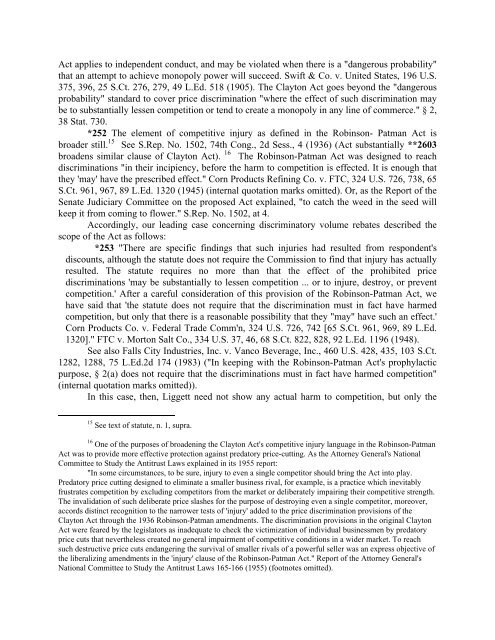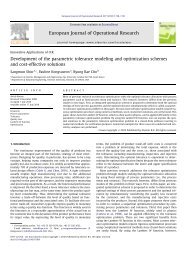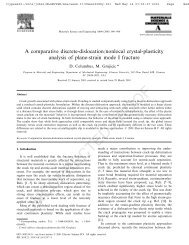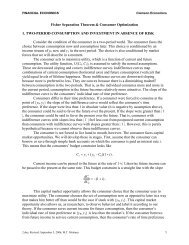509 U.S. 209, 113 S.Ct. 2578 BROOKE GROUP LTD., Petitioner v ...
509 U.S. 209, 113 S.Ct. 2578 BROOKE GROUP LTD., Petitioner v ...
509 U.S. 209, 113 S.Ct. 2578 BROOKE GROUP LTD., Petitioner v ...
Create successful ePaper yourself
Turn your PDF publications into a flip-book with our unique Google optimized e-Paper software.
Act applies to independent conduct, and may be violated when there is a "dangerous probability"<br />
that an attempt to achieve monopoly power will succeed. Swift & Co. v. United States, 196 U.S.<br />
375, 396, 25 S.<strong>Ct</strong>. 276, 279, 49 L.Ed. 518 (1905). The Clayton Act goes beyond the "dangerous<br />
probability" standard to cover price discrimination "where the effect of such discrimination may<br />
be to substantially lessen competition or tend to create a monopoly in any line of commerce." § 2,<br />
38 Stat. 730.<br />
*252 The element of competitive injury as defined in the Robinson- Patman Act is<br />
broader still. 15 See S.Rep. No. 1502, 74th Cong., 2d Sess., 4 (1936) (Act substantially **2603<br />
broadens similar clause of Clayton Act). 16 The Robinson-Patman Act was designed to reach<br />
discriminations "in their incipiency, before the harm to competition is effected. It is enough that<br />
they 'may' have the prescribed effect." Corn Products Refining Co. v. FTC, 324 U.S. 726, 738, 65<br />
S.<strong>Ct</strong>. 961, 967, 89 L.Ed. 1320 (1945) (internal quotation marks omitted). Or, as the Report of the<br />
Senate Judiciary Committee on the proposed Act explained, "to catch the weed in the seed will<br />
keep it from coming to flower." S.Rep. No. 1502, at 4.<br />
Accordingly, our leading case concerning discriminatory volume rebates described the<br />
scope of the Act as follows:<br />
*253 "There are specific findings that such injuries had resulted from respondent's<br />
discounts, although the statute does not require the Commission to find that injury has actually<br />
resulted. The statute requires no more than that the effect of the prohibited price<br />
discriminations 'may be substantially to lessen competition ... or to injure, destroy, or prevent<br />
competition.' After a careful consideration of this provision of the Robinson-Patman Act, we<br />
have said that 'the statute does not require that the discrimination must in fact have harmed<br />
competition, but only that there is a reasonable possibility that they "may" have such an effect.'<br />
Corn Products Co. v. Federal Trade Comm'n, 324 U.S. 726, 742 [65 S.<strong>Ct</strong>. 961, 969, 89 L.Ed.<br />
1320]." FTC v. Morton Salt Co., 334 U.S. 37, 46, 68 S.<strong>Ct</strong>. 822, 828, 92 L.Ed. 1196 (1948).<br />
See also Falls City Industries, Inc. v. Vanco Beverage, Inc., 460 U.S. 428, 435, 103 S.<strong>Ct</strong>.<br />
1282, 1288, 75 L.Ed.2d 174 (1983) ("In keeping with the Robinson-Patman Act's prophylactic<br />
purpose, § 2(a) does not require that the discriminations must in fact have harmed competition"<br />
(internal quotation marks omitted)).<br />
In this case, then, Liggett need not show any actual harm to competition, but only the<br />
15 See text of statute, n. 1, supra.<br />
16 One of the purposes of broadening the Clayton Act's competitive injury language in the Robinson-Patman<br />
Act was to provide more effective protection against predatory price-cutting. As the Attorney General's National<br />
Committee to Study the Antitrust Laws explained in its 1955 report:<br />
"In some circumstances, to be sure, injury to even a single competitor should bring the Act into play.<br />
Predatory price cutting designed to eliminate a smaller business rival, for example, is a practice which inevitably<br />
frustrates competition by excluding competitors from the market or deliberately impairing their competitive strength.<br />
The invalidation of such deliberate price slashes for the purpose of destroying even a single competitor, moreover,<br />
accords distinct recognition to the narrower tests of 'injury' added to the price discrimination provisions of the<br />
Clayton Act through the 1936 Robinson-Patman amendments. The discrimination provisions in the original Clayton<br />
Act were feared by the legislators as inadequate to check the victimization of individual businessmen by predatory<br />
price cuts that nevertheless created no general impairment of competitive conditions in a wider market. To reach<br />
such destructive price cuts endangering the survival of smaller rivals of a powerful seller was an express objective of<br />
the liberalizing amendments in the 'injury' clause of the Robinson-Patman Act." Report of the Attorney General's<br />
National Committee to Study the Antitrust Laws 165-166 (1955) (footnotes omitted).
















